TUCSON CACTUS AND SUCCULENT SOCIETY |
2022 - Monthly Meetings
First Thursdays January through November at 7 PM
A short business meeting followed by an informative presentation, door prizes, and free plants.
_________________________________________________________________
November 2022 Meetings
November 3, 2022 7:00 pm Miss it? We recorded it for you! Part 1 Part 2 "By Bike & By Boot: Landscape Design Lessons from Saguaro National Park" For over 25 years, desert landscape designer and author Scott Calhoun has visited Saguaro National Park at least once a week. Calhoun has been in the park in every season--after monsoon storms when grama grasses made the landscape look like Ireland with cactus—and during winter storms when the landscape was white and the barrel cactus were capped with snow. Even after all these years circumnavigating the same course, his loops haven’t become routine; the Park never fails to kindle astonishment. Join Scott as he shares images and stories of the plant combinations and lessons he has learned in the park. Scott Calhoun loves wildflowers, spiny plants, tacos, and rocks. He spends as much time as possible deep in the Mexican backcountry searching for new plants and eating local specialties. He has gardened in the American Southwest for over 20 years and is the author and photographer of six books about the region. Scott’s work has been featured in The New York Times and The Wall Street Journal. He writes a monthly column for Sunset magazine and freelances for numerous publications. Scott runs Zona Gardens, a design studio based in Tucson, Arizona. He designs, writes, and lectures throughout the United States. |
October 6, 2022 7:00 pm "Nature's Geometry: Succulents" Miss it? We recorded it for you! 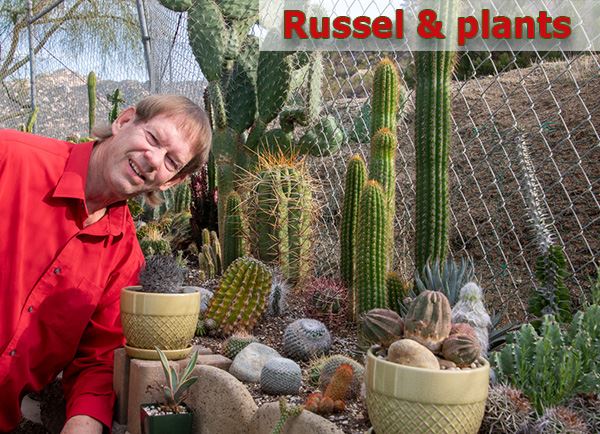 Russel uses the Fibonacci sequence of numbers to look at the shape of plants, the number of plant ribs, the number of spines in areoles, golden angles, phyllotaxis (the divergence angel), golden triangles, Fibonacci triangles, golden squares, golden rectangles, circles, fractals, and, most fascinating to him, golden spirals. He brings a selection of live succulents showing nature's geometry and will have copies for sale of his book, "Nature's Geometry: Succulents" a soft-cover book with over 600 pictures in 174 pages, discounted to $25 at the meeting. Russel is from Kingsville, Texas, where he was born and then raised mostly by his paternal grandmother. He has lived in the San Diego area since April 1993. He has been self-employed his entire life, mostly as a "serial entrepreneur" specializing in getting companies through star6tup and growth phases. He has owned businesses in grocery export, antique restoration, roofing, landscaping, international & wireless telecommunications, heating & cooling, computer sales, writing & editing, typing & desktop publishing, construction, real estate agent, real estate investing & renovating, project management, business consultant, home inspector, photographer, and author. A short Russel Ray timeline:
|
September 1, 2022 7:00 pm "Planning for Uncertainty; Conserving Cacti in a world of Change" Meeting recording Presented by Michiel Pillet |
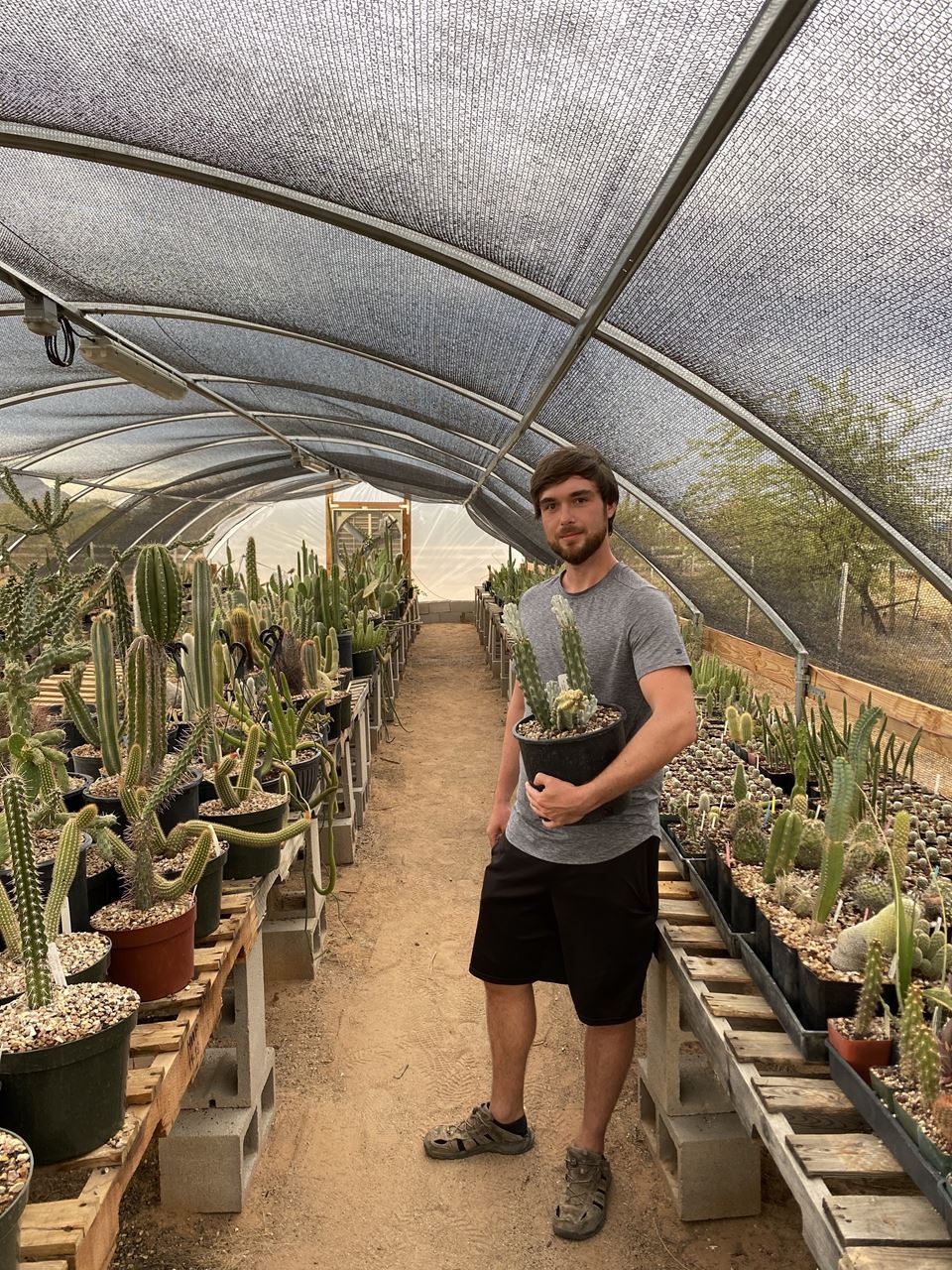
Cacti are one of the most endangered groups of organisms on the planet, being impacted by a host of factors such as habitat destruction and poaching. The effects of climate change on cacti until recently remained uncertain. On the one hand, a common perception is that future climate will be favorable to cacti as they have multiple adaptations to heat and drought. On the other hand, the wide diversity of the more than 1,500 cactus species, many of which occur in wetter and cooler ecosystems, questions the view that most cacti can tolerate warmer and drier conditions. What does the future hold for cacti? Come look into my crystal ball!Michiel Pillet is a doctoral candidate in the Department of Ecology and Evolutionary Biology at The University of Arizona here in Tucson, and a member of the IUCN Species Survival Commission Cactus and Succulent Plants Specialist Group. Dedicated to cactus conservation, he studies the impact of climate change on cacti. He became interested in cacti as a teenager growing up in Belgium, where he had a small cactus collection. When Michiel moved to Tucson in 2016, this quickly got out of hand. Last year, he opened a conservation-focused cactus nursery, Prickly Prospects, which focuses on ethical propagation of the most endangered species. He is involved in conservation projects with botanical gardens across the world. He believes strongly in the importance of holistic conservation management including both research in the field, as well as safeguarding the future of cacti by cultivating them. |
The endangered Uebelmannia pectinifera, from Brazil, predicted to lose nearly 75% of its range due to climate change |
August 4, 2022 7:00 pm "Kamikaze Botany and Other Tales of the Wild Sansevieria"
Kamikaze botany involves traveling long distances in uncomfortable vehicles seeking a few rare plants to photograph. Some sansevierias described long algo have been rarely visited and are not in cultivation (or widely distributed). Rather extreme measures are required to find some of these plants. This talk will discuss the results of two recent kamikaze botany trips to Tanzania and Malawi. But wait, there's more! A number of plants with locality data but not described as species have flowered recently in Tucson. These new species -- Sansevieria malabensis, S. butleri, S. phillipsii, and S. disticha, are currently in press in major journals, adding to the close to 100 species of sansevierias now known to science. Finally, Bob Webb recently collaborated with Len Newton to write a book on sansevierias entitled "The Genus Sanseviera: A Pictorial Guide to the Species". He will discuss the trials and tribulations of doing botany in Africa with a mind for finding new species. |
July 7, 2022 7:00 pm Not all Bugs are TRUE BUGS Meeting recording
Presented by William D. "Bill" Peachey
In the late 1990s, having finished a nectar-feeding bat grant, he turned a data gathering aspect of that grant into the beginning of the first detailed study of the bloom phenology of the saguaro cactus that continues today near the east end of Rincon Valley some 26 years later and 27 miles SE of downtown Tucson. At the time, he had no idea just how "buggy" things were to become... During the bat studies, he had discovered a relationship between Pallid Bats & the Mesquite Bug. If you like "big" bugs - the Mesquite Bug is the one for YOU as, in its Family of the "Leaf-footed Bugs" that are "True Bugs", it is the largest species found in North America! In the mesquite-covered bottomlands that are its most favorable habitat, its adults can attain body lengths of 2 inches. The data collection about this bug spanned years and was a "portent" of things to come concerning "bugs" and cacti. If you have interest in the Mesquite Bug and its bat predator, here is the link to the study that resulted: https://peerj.com/articles/6065 During the early 2000s, Bill found out that there is a group within the Family of "Leaf-footed Bugs" called All of those who resided in Tucson through the 2021 Monsoon last year were both amazed and gratified that we received record rainfall during the month of July and that the 2021 Monsoon recorded the 3rd greatest amount of rain...ever!
A recipe herein, provided by Vonn Watkins, Vice President of TCSS, gives the directions for a "sure fire" bug-killing mixture. In one gallon of water add about a cup of each of these items, Dawn Ultra dis soap, Pine-Sol, 70% Isopropyl Alcohol and only about 2 tablespoons of Neem Oil. Use the mixture in a sprayer. Works great for Cochineal! This will be followed by a very short explanation of this years saguaro bloom.... Vonn Watkins and Doug Rowsell have made Bill promise to limit himself to no more than 15,000 words!!! |
May 5, 2022 7:00 pm
Shining a Light on a Hidden Agave: When you know that they don't know that they don't know
Meeting recording Presented by Tristan J. Davis
Notes for attending the in-person meeting: | Have you ever looked at a plant with ID and thought, "Hmmm...that's weird"? Trying to answer those types of questions is what Science is all about. In this presentation, Tristan will take you on a storybook adventure with Greg Starr that ended in a surprising place. It all started with a photo and someone saying, "Something is goin on here". The story will take us from the Internet, to a nursery, to our gardens, and all the way to Mexico. It's a story that has a happy ending = and lots of pretty photos! It's also a story that has an unwritten sequel. Born into a very "outdoorsy" family, Tristan was introduced to the natural World at a very young age. His initial interest was specific to South American birds, and subsequent education at Louisiana State University and the University of Kansas allowed him to accompany scientific expeditions to most South American countries, as well as China, the Philippines, and Equatorial Guinea. It was obvious early on in
If you have been fully vaccinated for Covid-19, you are welcome to come and join us for this excellent in-person presentation (masks will be required by all). This meeting will also be a Zoom program and will be an important educational and informational event you must see. Also, if using Zoom, be sure to log in to win a $25.00 give certificate from TCSS or choose a copy of the new 3rd edition of the Field Guide to Cacti & Other Succulents of Arizona. Plant give aways will take place at the in-person meeting but that portion of the program, because of the recording, will not appear on Zoom. When leaving the live in-person meeting, everyone can get a free plant offered to you by the TCSS. |
April 7, 2022 7:00 pm
Feeding Succulents: How Fertilizer, Water pH and Soil Can and Should Be Adjusted!
Meeting recording Presented by Ernesto Sandoval
April 7, 2022 7:00 pm Feeding Succulents: How Fertilizer, Water pH and Soil Can and Should Be Adjusted! Presented by Ernesto Sandoval
Ernesto Sandoval has been wondering and seeking questions and answers to why plants grow and look the way that they do for nearly 40 years. Now he explains and interprets the world of plants to a variety of ages and from amateur to professional gardeners. He regularly lectures to a variety of western Garden Clubs throughout the year and particularly to Succulent Clubs throughout California. Desert plants are his particular passion withing his general passion for plants. He describes himself as a "Jose of All Plants, Master of None" and loves learning from the experiences of others as well as his own. Ernesto thoroughly enjoys helping others, and gardeners in particular, to understand why and how plants do what they do. When he was about 13 he asked his dad why one tree was pruned a particular way and another tree another way. His dad answered bluntly "because that's the way you do it". Since then he's been learning and teaching himself the answers to those and many other questions by getting a degree at UC Davis in Botany and working from student weeder/waterer to /Director/Manager over the last 30 years at the UC Davis Botanical Conservatory. He's long left the "mow blow and go" monoculture landscape gardening world and has immersed himself in the world of horticultural biodiversity by growing several thousand types of plants at the the UC David Botanical Conservatory, many of them succulents! Several of his favorite garden projects involved converting lawns and or water loving landscapes to drought tolerant and diversity filled gardens! He likes to promote plant liberation by encouraging gardeners of all sorts to grow more plants in the ground when possible. He loves the technical language of Botany but prefers to relate information in more understandable methods of communication! By helping people to understand the workings of plants he hopes to help us better understand how to and why our plants do what they do and how we can maximize their growth with less effort. If you have been fully vaccinated for Covid-19 you are welcome to come and join us for this excellent in-person presentation (masks will be required by all). This meeting will also be a Zoom program and will be an important educational and informational event you must see. Also, if using Zoom, be sure to log in to win a $25.00 gift certificate from TCSS or choose a copy of the n ew 3rd edition of the Field Guide to Cacti & Other Succulents of Arizona. Plant give aways will also be happening at the in-person meeting as well. When leaving the live in-person meeting, everyone can get a free plant offered to you by the TCSS. Ernesto will also have some special plants he will be bringing for sale to the membership. |
March 3, 2022 7:00 pm
Meeting recording Presented by: Steven Brack
The program will be a tour of southern Namibia and an introduction to the major succulent families of plants. The diversity of plant life is huge, with tiny to large succulents. The coastal regions are strongly influenced by the cold waters of the Atlantic Ocean with a lot of haze in the ai, higher humidity, and fog and drizzle in the winter. The eastern side of the country has an intermittent summer monsoon with moisture coming south from Angola nd occasional thunderstorms popping on summer afternoons.
Steven has taken 5 trips to Namibia since 1982 and have been very impressed by the beauty of the country. It is a large country with vast amounts of land with little human influence. The southern desert region can be very harsh with low rainfall, but this is not the whole story. There are many plants and animals that survive and call this area home.
Steven was interested in horticulture from a very young age. Growing up on a small family dairy farm in Wisconsin, he started working in the garden as a lad. This interest in plants caused him to go to the local college library after seeing come cacti at a friend's house. For quite some time his interest was in finding more books on cacti and succulents through library loan. In one of the books, he found that it was possible to join Societies and send away for seeds. Early on he got the raising-from-seed bug and eventually decided to move to a desert state, New Mexico, to start a nursery to produce seeds. Once the ball got rolling, it just kept on going, he and his wife started Mesa Garden in 1976 and pretty much the rest is history. One of the best parts of the work was taking trips to see plants in nature, and they continue to do this now. In late 2016 they sold Mesa Garden to retire and now are as busy as ever with plants, growing from seed, and family.
If you have been fully vaccinated for Covid-19, you are welcome to come and join us for this excellent in-person presentation (masks will be required by all). This meeting will also be a Zoom program and will be an important educational and informational event you must see. Also, if using Zoom, be sure to log in to win a $25.00 gift certificate from TCSS or choose a copy of the new 3rd edition of the Field Guide to Cacti & Other Succulents of Arizona. Plant give aways will also be happening at the in-person meeting as well. When leaving the live in-person meeting, everyone can get a free plant offered to you by the TCSS.
February 3, 2022 7:00 pm Meeting Video
"Following the Footsteps of a Forgotten Botanist: A Visual Journey of the Life and Work of Sara Plummer Lemmon"
Presented by: Wynne Brown |
| In this presentation, Wynne Brown, author of the recently released biography of Sara Lemmon, will reveal the story behind The Forgotten Botanist. Along the way, she'll show examples of plants discovered by and named for this remarkable 1880's woman, as well as sharing a sample of Sara's surviving botanical illustrations. Wynne Brown is a freelance writer/editor/graphic designer, based here in Tucson. Her books include More Than Petticoats: Remarkable Arizona Women, The Falcon Guide to Trail Riding Arizona, and Cave Creek Canyon: Revealing the Heart of Arizona's Chiricahua Mountains. She is also president of the Chiricahua Regional Council and represents Pima County on the State Board of the Arizona Historical Society. In addition, she will be the Pima County Public Library's Writer in Residence from Feb 1 - April 30, 2022. |
|
January 6, 2022 7:00 pm Meeting Video
Presented by: Jeff Moore
Solana Succulents, Solana Beach, CA
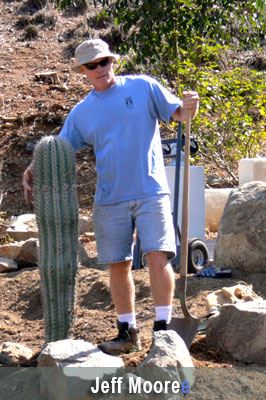 Agaves - Species, Hybrids and Cultivars takes a deep dive into the world of agaves, both cultivated and in their native habitat. This program is based on the recent book publication by Jeff Moore and co-authored with agave expert Jeremy Spath. Cultivars and hybrids will be shown and discussed as well as the majority of species.
Agaves - Species, Hybrids and Cultivars takes a deep dive into the world of agaves, both cultivated and in their native habitat. This program is based on the recent book publication by Jeff Moore and co-authored with agave expert Jeremy Spath. Cultivars and hybrids will be shown and discussed as well as the majority of species.
The presentation follows the flow of the book, with most of the PowerPoint images from the book itself. The majority of the species are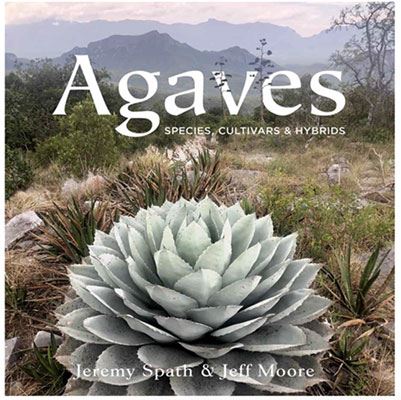 covered, with images both in habitat (when possible) and in cultivation. There is also a chapter on established and new hybrids, as well as the relatively new phenomenon of mangaves. The program will show examples of agaves as ornamentals, Jeff will take a look at the history of agaves as commercial plants, for fiber, food, and of course the genus' most well known byproduct - tequila and mescal. From an ornamental perspective, there are some beautiful detailed images of agave spines and imprinting, as well as some of the more impressive variegated and collector forms.
covered, with images both in habitat (when possible) and in cultivation. There is also a chapter on established and new hybrids, as well as the relatively new phenomenon of mangaves. The program will show examples of agaves as ornamentals, Jeff will take a look at the history of agaves as commercial plants, for fiber, food, and of course the genus' most well known byproduct - tequila and mescal. From an ornamental perspective, there are some beautiful detailed images of agave spines and imprinting, as well as some of the more impressive variegated and collector forms.
Most of the images were taken by the authors, but we also included many beautiful photos from contributors such as Bryan Kemble, Jeff Chemnick, Tony Krock, and other knowledgeable enthusiasts.
Jeff has owned and operated Solana Succulents since 1992. It is a small retail specialty nursery, and carries as much of the rare and unusual as possible, along with more common and colorful succulents. The agave book is my fifth self-published book about succulents. www.solanasucculents.com
If you have been fully vaccinated for Covid-19, you are welcome to come and join us for this excellent in-person presentation (masks will be required by all). This meeting will also be a Zoom program and will be an important educational and informational event you must see. Also, if using Zoom, be sure to log in to win a $25.00 gift certificate from TCSS or choose a copy of the new 3rd edition of the Field Guide to Cacti & Other Succulents of Arizona. Plant give aways will also be happening at the in-person meeting as well. When leaving the live in-person meeting, everyone can get a free plant offered to you by the TCSS.


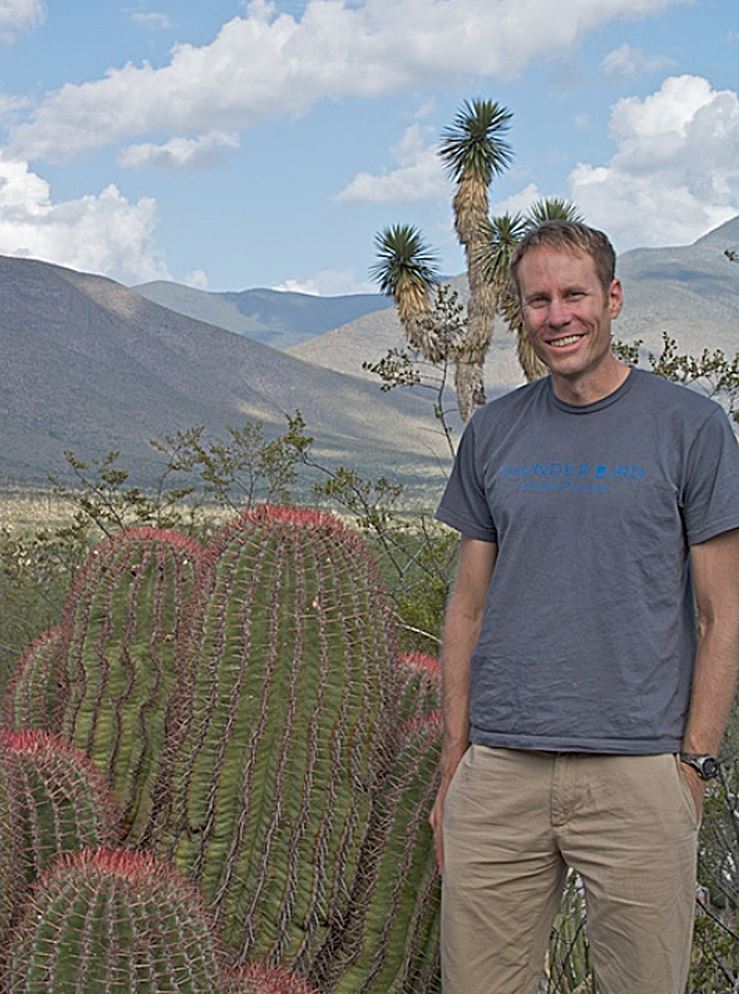

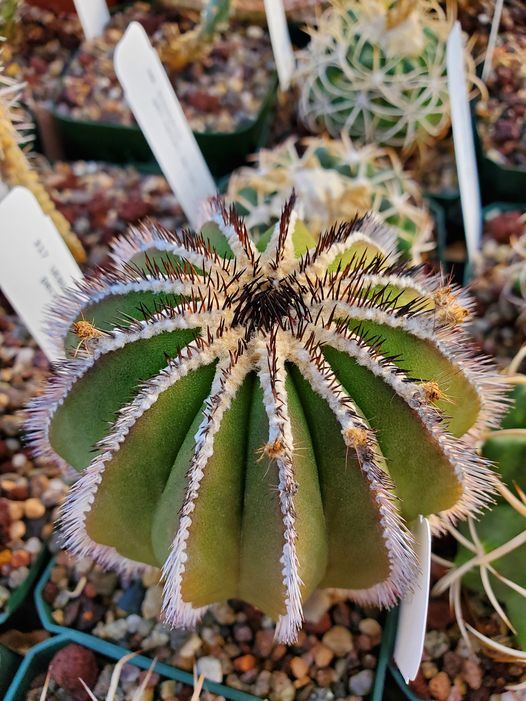

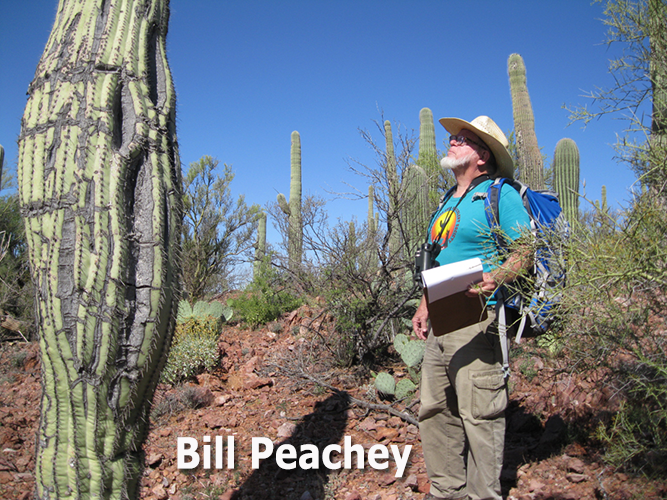 Kids that grew up in the post-WWII Phoenix area had easy access to extensive tracts of the surrounding Sonoran Desert to explore and learn about; and many of them only became "civilized" well after they had already become confirmed "desert rats"! Bill Peachey was one of those lucky ones and was fortunate to have developed an all-consuming interest in desert "critters" (at that time...especially the arthropods!) that eventually led him to a lifetime of ecological studies facilitated through field science.
Kids that grew up in the post-WWII Phoenix area had easy access to extensive tracts of the surrounding Sonoran Desert to explore and learn about; and many of them only became "civilized" well after they had already become confirmed "desert rats"! Bill Peachey was one of those lucky ones and was fortunate to have developed an all-consuming interest in desert "critters" (at that time...especially the arthropods!) that eventually led him to a lifetime of ecological studies facilitated through field science.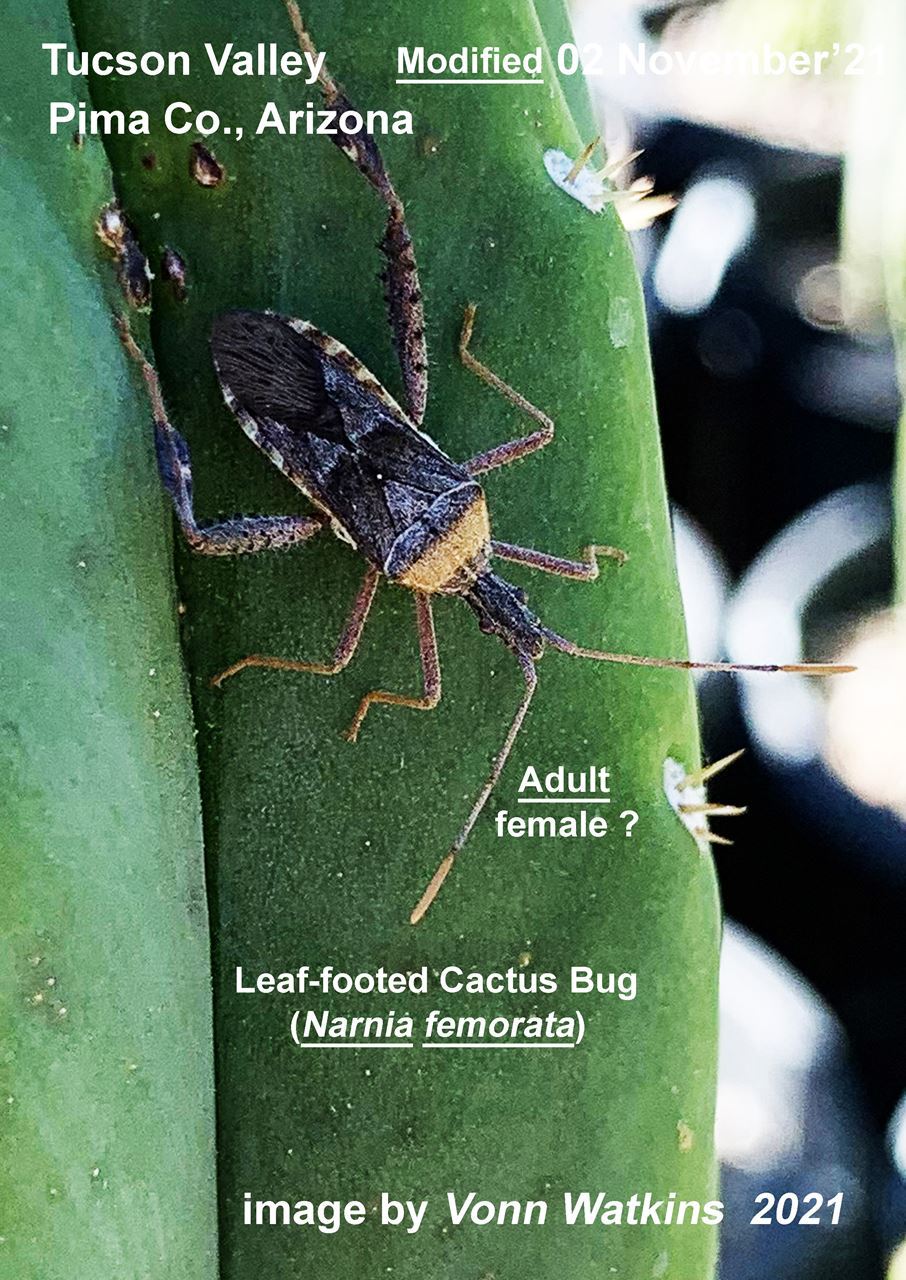 the "Cactus Bugs". It contains several Genera that consist of a number of species. He was surprised to find that several of these take great delight in feeding on Saguaros. And, he has determined over the past two years that presently just two species of these "Cactus Bugs" are, by far, the most numerous and so are probably doing the greatest amount of damage to our cacti.... The following presentation elaborates upon what is now known.
the "Cactus Bugs". It contains several Genera that consist of a number of species. He was surprised to find that several of these take great delight in feeding on Saguaros. And, he has determined over the past two years that presently just two species of these "Cactus Bugs" are, by far, the most numerous and so are probably doing the greatest amount of damage to our cacti.... The following presentation elaborates upon what is now known.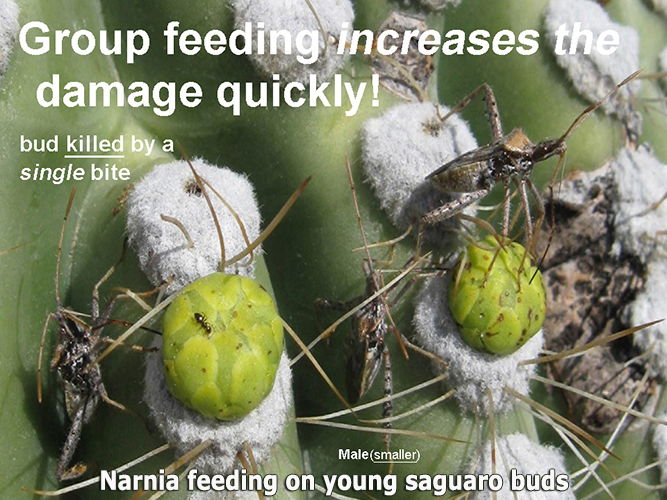 Unfortunately, "plenty" is sometimes accompanied by negative attributes. So this year we see extra ground-fire fuels from last summer 2021s growth of various "weedy" and non-weedy plants and, similarly, we have now received a "bumper crop" of several species of cactus-eating "True Bugs"! These insects are rarely responsible for killing our cactus garden specimens but, they leave unsightly scarring where they have fed and can damage stem tip growth points that can then cause deformed stems of not only native cactus species, but also some of our larger showy non-native cactus species....such as the Mexican Fence Post Cactus. In the presentation, Bill will first discuss how to tell just what a "True Bug" is. Then the talk will move on in order to identify the "culprit" bug species, describe where to look for them, relate indirect signs of their presence, and, finally, give a relatively easy and very effective way to rid your cacti of them...
Unfortunately, "plenty" is sometimes accompanied by negative attributes. So this year we see extra ground-fire fuels from last summer 2021s growth of various "weedy" and non-weedy plants and, similarly, we have now received a "bumper crop" of several species of cactus-eating "True Bugs"! These insects are rarely responsible for killing our cactus garden specimens but, they leave unsightly scarring where they have fed and can damage stem tip growth points that can then cause deformed stems of not only native cactus species, but also some of our larger showy non-native cactus species....such as the Mexican Fence Post Cactus. In the presentation, Bill will first discuss how to tell just what a "True Bug" is. Then the talk will move on in order to identify the "culprit" bug species, describe where to look for them, relate indirect signs of their presence, and, finally, give a relatively easy and very effective way to rid your cacti of them...
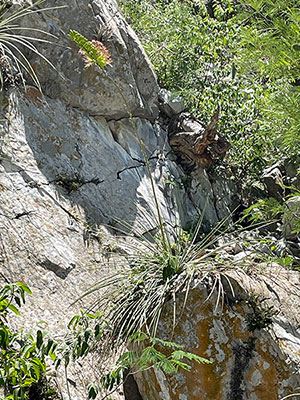
 his travels that Tristan much preferred those locations with less humidity (western Peru, the pampas of Argentina, etc.), and this was a significant reason he moved with his husband to Arizona in 2001. Once arriving in Arizona, Tristan readily transitioned his scientific passions to cacti and succulents, and although Tristan has authored numerous scientific publications related to ornithology, he published his first paper on desert succulents in 2011 in the Cactus & Succulent Journal. Tristan's current interests and scientific travels include Mexican agaves with Greg Starr, Peruvian Puya, and South American Cleistocactus, as well as neotropical birds. And whatever else piques his interest along the way. Tristan currently resides in Chandler, AZ and is a member of the Central Arizona Cactus and Succulent Society; he served on the Board of Directors for the society, and currently administers the Propagation Education Group (PEG), the Research Grant Program, and the Seed Depot for the society. Tristan also volunteers in the Horticulture, Research, and Education departments at the Desert Botanical Garden.
his travels that Tristan much preferred those locations with less humidity (western Peru, the pampas of Argentina, etc.), and this was a significant reason he moved with his husband to Arizona in 2001. Once arriving in Arizona, Tristan readily transitioned his scientific passions to cacti and succulents, and although Tristan has authored numerous scientific publications related to ornithology, he published his first paper on desert succulents in 2011 in the Cactus & Succulent Journal. Tristan's current interests and scientific travels include Mexican agaves with Greg Starr, Peruvian Puya, and South American Cleistocactus, as well as neotropical birds. And whatever else piques his interest along the way. Tristan currently resides in Chandler, AZ and is a member of the Central Arizona Cactus and Succulent Society; he served on the Board of Directors for the society, and currently administers the Propagation Education Group (PEG), the Research Grant Program, and the Seed Depot for the society. Tristan also volunteers in the Horticulture, Research, and Education departments at the Desert Botanical Garden.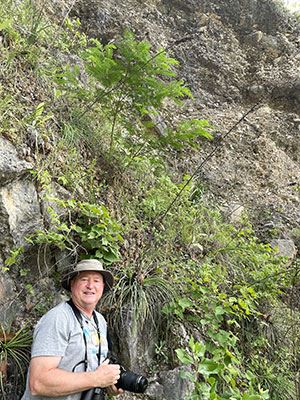
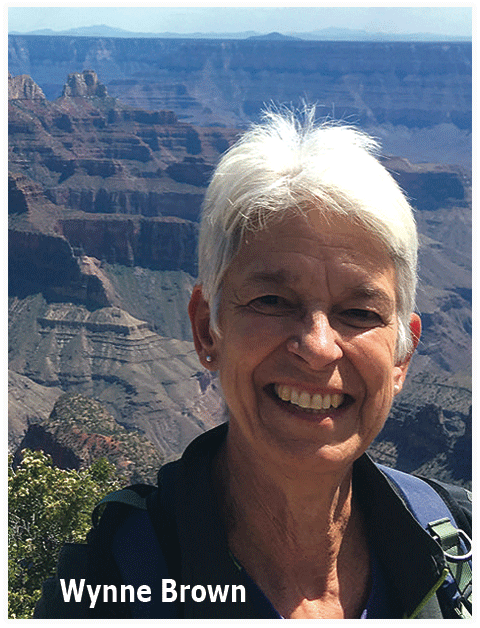
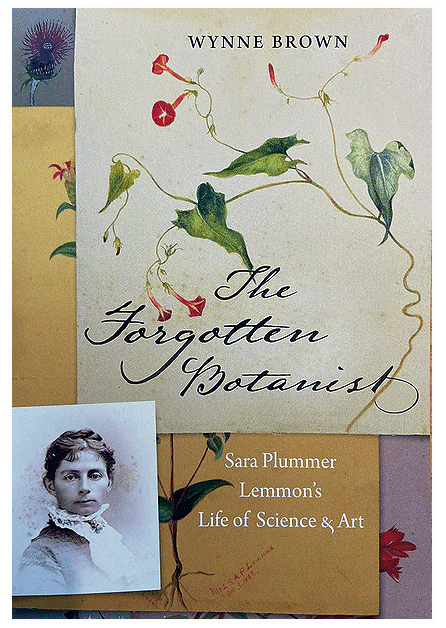


.png)
